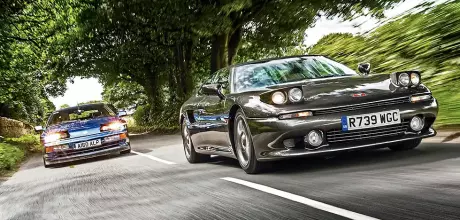1992 Alpine A610 vs. 1997 Venturi Atlantique 260
In the 1990s, France produced a showdown between two glassfibre-bodied supercoupés with boosted Renault V6s: the Alpine A610 and Venturi Atlantique. Do they deserve to remain in perpetual obscurity?
Words KEITH ADAMS
Photography ADAM SHORROCK
Two Renault-powered French supercars meet on the road
French New Wave Venturi Atlantique vs Alpine A610: Renault V6 supercars do battle
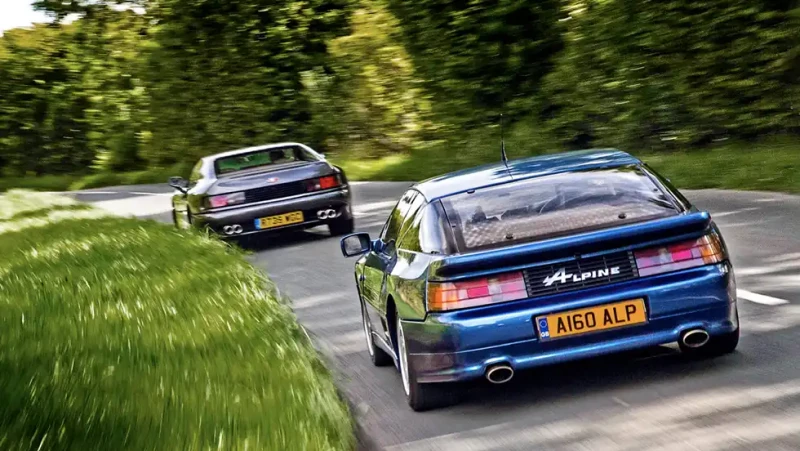
‘The lag-then-surge becomes addictive once I’m dialled into it’
As I regard the pair of polished, distinctive Porsche rivals before me, I find myself wondering why French sports cars like the Alpine A610 and Venturi Atlantique 260 are so rare. They sprung from the nation of Le Mans, arguably the one that invented motor sport full stop. Both hail from a tradition of Renault-engined garagiste specials that have at times dominated Formula One and sports-racing alike. And yet, neither ever troubled sales of Porsche or Ferrari. Today, I’m going to drive both and find out whether either car deserved to sell better than it did.
A610 owner Vince Santini arrives at our test day first after a long early-morning commute in his 1992 example, and it’s clear he’s very relaxed and comfortable with his lot – it’s a consummate motorway car he says, and great fun to drive in the Cotswolds backlanes. Seems like reason enough to jump in and take it for a quick spin to get familiar with it.
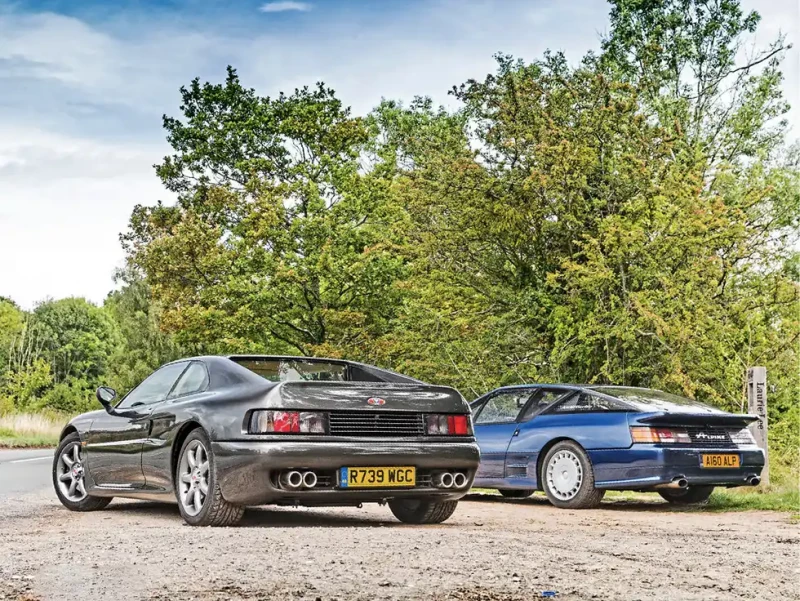
‘Despite mass-produced switchgear, both still feel bespoke and special in an unexpected way’
Inside, it’s a very mixed bag. The floor-hinged pedals might add a layer of quirkiness, but that’s countered by the quite ordinary instrumentation, uninspiring dashboard and standardfare Renault steering wheel. Vince has done a great job of retrimming his car, and I love the GTA-spec leather seats he’s fitted, much more interesting-looking than the cost-constrained A610 pews. The best news soon becomes apparent, and it’s quite simple – the A610 really isn’t an intimidating car to drive at all. It’s a large car – wide, low, and very much an old-school supercar in its proportions – but with all that glass and decent seating position, it’s easy to see out of. Look behind, and there’s even a pair of vestigial rear seats. Probably best for your luggage, rather than anyone with legs or a head.
Fire it up, though, and it sounds very fruity. Vince tells us that the straight-through exhausts are far from standard, explaining some of that magnificent soundtrack. Acceleration is rapid rather than ballistic, but it’s enough to trigger all manner of synapses thanks to the amazing baritone engine note bellowing its V6 music as you search for the redline. Wow.
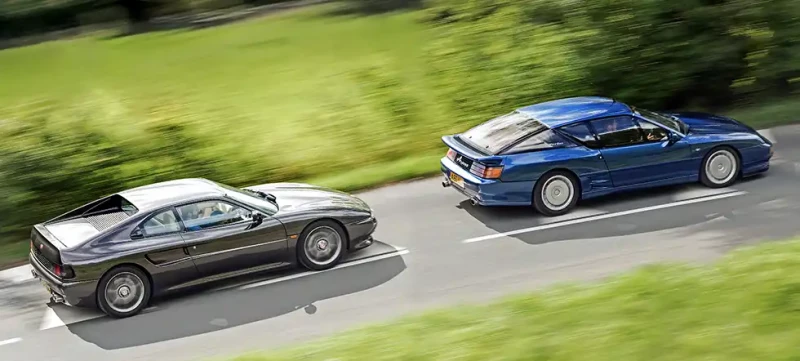
The flow is hampered a little by the long and slightly obstructive gearchange, but given the heavy flywheel and the engine’s tardiness in dropping its revs, slow gearchanging is probably the best course of attack for the keen driver. Does it feel like a sub-six-second 0-60mph car? Not entirely, but I’m still impressed by the way it accelerates. It’s also commendably poised, too. As the speeds rise, the A610 seems to hunker down and feel at one with the road surface – a fact I deeply admire, while crediting Alpine’s clever set-up, Vince’s suspension drop and the car’s impressive aerodynamics.
Before we get to exploring the A610’s handling proposition, the Venturi and its owner Paul Hughes rock up. The first thing that occurs to me is how surprisingly small the Atlantique appears alongside the A610 – it’s a pert thing indeed, all tightly packaged, and lacking anything in the way of flab. It also looks sensational – a real Ferrari-esque effort. I love it.
These two innovative companies came up with sports car ranges that stood apart from the brilliant hot hatches and super-comfortable executive cruisers typifying France’s automotive output at the time. Both were of composite construction; both featured unconventional suspension and plenty of power from forced-induction V6 engines. The similarities end there, though. The Venturi is mid-engined and looks like a Ferrari 348/F355 mash-up, while the rear-engined Alpine is unashamedly styled like no other car on the planet. Both drip with cool attitude – but are they any good? Just four Venturis and 22 A610s remain in the UK, but thanks to these two enthusiastic owners, we’ve managed to bring them together here.

These are two of the most striking super-sports cars of their era, and yet the chances are you either won’t have heard of them, or will get the name wrong. Thanks to the launch of the Porsche Cayman-troubling Alpine A110, this French sports car maker is finding itself on the radar of enthusiasts everywhere. But back in the Nineties, when you could last buy a new Alpine, it was actually called the Renault A610 Turbo in the UK. You can put this naming anomaly down to PSA owning the rights to the Alpine nameplate here, a historic legacy of its absorption of the Sunbeam concern. In all other markets it was sold in, however, it was rightfully called the Alpine A610 Turbo.
As for the Venturi, unless you were there in the Eighties and Nineties, I’ll forgive you if you’ve not come across it before.
‘Both hail from a tradition of Renault-engined garagiste specials that have at times dominated F1 and sports-racing’
Launched in 1987 just three years after first being shown in prototype form, the MVS Venturi was an intriguing composite-bodied mid-engined sports car, powered by a 2.5-litre Renault turbo engine developing 200bhp. It combined good looks with race car engineering, and soon picked up a healthy following in its home market, with more than 200 coming off the production line in Couëron, Pays de Loire, over the course of the next two years.
For Venturi to make any kind of splash in 1987 was a very impressive feat indeed. It was priced against the Porsche 911 and Ferrari 328, and was considerably more expensive than France’s previous super sports car flagship, the Alpine GTA. That car had been launched in 1984, and like the cars it succeeded – the A110 and A310 – it had a steel backbone chassis, was rear-engined and dramatically styled. Like the Venturi that would come to oust it at the top of the French car market, it was composite bodied, and featured smoothly integrated bumpers and highly aerodynamic styling, with parent company Renault quoting a drag coefficient of 0.30Cd.

The major similarity between the two cars lay under the engine cover, though – both were powered by the same 2.5-litre Peugeot/Renault ‘Douvrin’ engine, rated at 200bhp. Although the GTA would prove to be a critical success because of its clever packaging and impressive handling, it sold in smaller numbers than its maker hoped for, with production rarely topping 1000 cars per annum at its factory in Dieppe.
But that didn’t stop Renault developing the GTA. In 1990, five years after it went on sale in the UK, the far more muscular-looking Le Mans edition arrived. It received a wider bodykit, and smaller, more aggressive headlamps. With larger three-piece BBS alloys, it had all the attitude that the original car lacked – and paved the way for the much harder-looking A610, which would be launched in 1991.
Although the A610 outwardly looked like a GTA, only the glass is shared between the two cars. And under the skin, there were many engineering changes. A significantly updated 2975cc Douvrin V6 turbo was the highlight of the package, now developing 247bhp and 258lb ft for a 5.9 sec 0-60mph sprint, and a maximum speed of 165mph.
Its pop-up headlights added sex appeal, but commercially, the model was far from successful – by the time it went out of production, 818 were built with 68 in right-hand-drive form.
For Venturi, the Nineties were proving equally troublesome – in 1991, the more powerful, lighter Atlantique 260 made its debut, and its maker became increasingly embedded in motor sport; that well-proven cash-burning method. Still, the Venturi LM500 was quite a swansong, with its F40-style rear wing.
In 1994, the Atlantique 300 was unveiled. This, a clever update of the original car, was styled by company boss Gérard Godfroy, and re-engined with the latest 3.0-litre, 24-valve Douvrin V6. In naturally aspirated form, it was good for 210bhp, while the forced-induction model pushed out an enticing 281bhp.
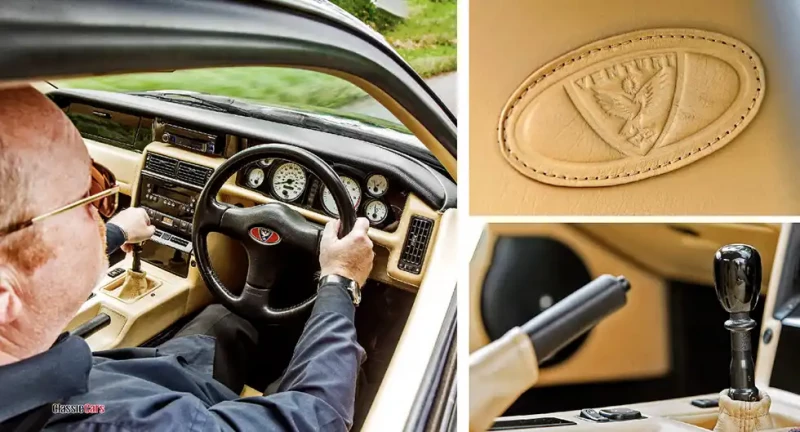
Fire this 260 up, and it all feels a lot more muted than Vince’s pumped-up A610. The V6 might be just behind your left ear, but it settles to a calming hum that’s nevertheless slightly tainted by valvetrain noise. Throttle response is certainly lazier than its rival, and initial thoughts are that this is more of a cruiser that’s been tuned to massage the egos of their owners. But that first impression melts away when I’m more brutal with the throttle. The step up in boost when the turbo has fully spooled up beyond 3000rpm is rather impressive.
Inside, the Venturi is even more impressive. Whereas the A610’s mass-produced roots are all-too apparent, the Venturi cockpit is a thing of beauty. Every part in here has been beautifully hand-crafted from the finest materials, and in many ways, it reminds me more of an Aston Martin in terms of the taste of its colour matching, as well as its sheer quality and finish. Yes, a trained eye will find PSA switches and controls scattered throughout, but you really won’t care one jot. The gearchange is notchy and very mechanical, but is less obstructive than the A610’s, and I soon learn to work with it to change ratios smoothly. There’s no escaping the boostiness of the acceleration – the lag-then-surge becoming addictive once I’m dialled into it – and the fact that it has just a little more topend bite than the A610, even if you don’t get the impressive soundtrack. The good news is that although it’s quieter, the Venturi still sounds way better than any car powered by a mass-produced engine has any right to, and you’ll be rolling down the windows just to get a better listen.
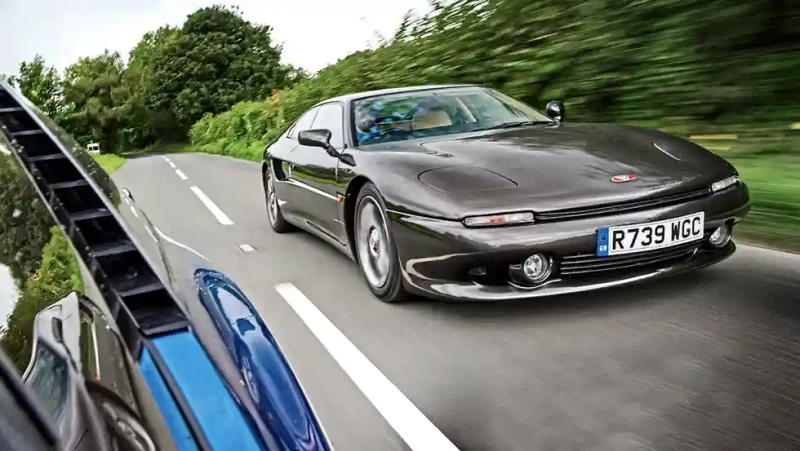
I take some time to feel the Atlantique into a series of interesting sweeping bends, and its handling comes as something of a shock. Considering this car rides so well, its turn-in and mid-corner poise are phenomenal. I’d expected it to be firm and joggly, which is never ideal on British B-road bends, but it’s well-damped, supple and resists bodyroll. In fact, it seems to have Lotus levels of chassis development – but with a better interior. Overall, then, an impressively sorted sub-supercar which makes it a struggle to explain why it didn’t sell better, other than for the want of a better badge on its rump. Jumping back into the A610 and attacking the same set of bends, it’s hard to brush off the initially stiffer ride, and more rattly interior, despite Vince’s best efforts to effect cure. It’s also noisier, has heavier steering and feels less composed at low speed. But go faster and the magic show starts as the A610’s damping wakes up and helps keep the car planted on the road.
The steering is full of feel, precise and well-geared. Here’s a steering set-up that’s been tailored for enthusiasts who revel in knowing what’s occurring below the tyres. Bends are shrugged off with ease, and the roll-free A610 seems to float across every camber and surface irregularity in the most masterful way. Dynamically, this turns out to be a split decision. The A610’s more resolved handling counterbalances the Venturi’s effortless refinement. Inside and out, the Venturi trounces the A610, but then, in terms of living with one in the real world, I’d probably wimp out and take that car’s better parts backup and potentially lower running costs every time.
So what of the original question – did this pair have what it took to beat more established European opposition and, if so, which of them does it most convincingly?
Although both of these cars rely on Renault/PSA powertrains, and have cabins littered with mass-produced switchgear, both still feel bespoke and special in an unexpected way. Just as a Lotus Esprit electrifies you with a character of its own, despite its Morris Marina door handles, the Renault A610 Turbo and Venturi Atlantique are sprinkled with stardust, and both will win you over by the end of the briefest of drives.
They are both very different in their appeal. The Ferrari-like Venturi Atlantique is a thing of beauty, and engineered to within an inch of its life, while the Renault A610 Turbo is a handling masterclass; choosing between the two is very difficult indeed. If you’re looking for a driver’s car first and foremost, then the A610 must surely be the one on the strength of its impressive handling, levels of grip and steering feel.
But the Venturi feels altogether more bespoke, and although its more laid-back character lulls you into a feeling that this is a cruiser built for the long schlep down to the Cote d’Azur, it will allow an impressive turn of speed once it’s wound up. It feels more puppy-footed on the road, but its handling is more predictable at the very edge of its abilities. So, taking into account that current values put these two cars more or less on a level footing, you’d have to say that the Venturi makes the more appealing long-range, GT option. Would I take them both over a Porsche 968 or Lotus Esprit? Yes, in fact, I would.
For those intending to justify long-term ownership, the A610 is probably the stronger bet. With more brand visibility, thanks to Renault’s continued corporate backing and the capability of the amazing modern A110, you can see more buyers being swept up by the striking A610, which ultimately means more potential value growth than the more esoteric Venturi.
So, I’ll plump for the Alpine A610, but take a lingering, wistful look at the Venturi whenever I see one. Fortunately, that won’t be very often at all.

Both are obscure but perfectly respectable takes on the genre.
Plush Venturi cabin has Aston undertones. Midship layout means poor DIY accessibility.
Alpine’s retrofuturist cabin charms today. Hidden plumbing can mean neglected turbo maintenance.
Venturi boasts white dials for max legibility. Sierra Sapphire called, wants its lights back.
Embrace the Ferrari comparisons; ignore the Ford Probe ones PRV takes Alpine to a heady 165mph. Both are from the twilight era of pop-up lights. Alpine unmistakable; Venturi a bit of a Franco-Ferrari.
Artisinal touches charm Venturi occupants Five-speed manual is tres mechanique. Venturi’s supple ride yet flat cornering wows.
Modern head unit nestles among borrowed switches 90
Alpine had low expectations in the UK market.
WHO IS… ALPINE
Alpine was launched by Jean Rédélé in the mid-Fifties, building race and road cars in Dieppe. Its most successful competition era was the Seventies, with World Rally Championship and Le Mans victories. The firm itself was taken over by Renault in 1973, ahead of a merging with Renault tuning compatriot Gordini to form RenaultSport. The A110 was replaced with the A310, which originally used a 1.6-litre four-cyl, and later a PRV V6. The Alpine GTA followed, with n/a and turbo PRV V6s. A widebody version followed in 1990, before it was replaced with the A610. The brand halted in 1995, the Dieppe-built but Renault-badged Sport Spider and Clio V6 maintaining the bloodline before Alpine was relaunched in 2017 with a new-gen A110. A new electric hot-hatch model is imminent.
WHO IS… VENTURI
Venturi was started by two former Peugeot/Citroën engineers, Claude Poiraud and Gérard Godfroy, in 1984 as MVS (Manufacture de Voitures de Sport). Early cars used Golf GTI and Peugeot 505 engines, but by 1985 the firm had settled on the PRV V6, and a name, the MVS Venturi. Engine output ranged from 160bhp to 260bhp, and even spawned a single-marque race series. The Venturi Atlantique, a rework of the MVS, appeared in 1996, with an even more pumped up race version. Venturi went bankrupt in 2000, but it was bought by Gildo Pallanca Pastor in 2001. It has since focused on producing electric cars and motorcycles. It set the electric world land speed record in 2016, and competed in Formula E until 2022, when the outfit was bought out by Maserati.
OWNING A VENTURI ATLANTIQUE
‘I’ve had my Venturi for a decade, during which I’ve been restoring it,’ says Paul Hughes. ‘I’ve also had an A610, which I sold to buy the Venturi. I love both, but couldn’t afford to keep two. The Venturi feels more special, more modern and better made. The seats in the Venturi are miles better than the A610’s. I’d have another A610, but probably wouldn’t swap it for the Venturi.’
OWNING A RENAULT A610
‘I have had mine five years, three of which have been spent on restoration,’ says Vince Santini. ‘I would love to try life with the Venturi, but at the end of the day I love the unique look of the A610 over the Ferrari-looking Venturi. Plus, the A610 has more accessibility for maintenance by the DIY owner. I love the A610’s design and pop-up lights, its rarity and the attention you get driving it on the road.’
TECHNICAL DATA 1992 Alpine A610
- Engine 2975cc V6, sohc per bank, AEI electronic fuel injection, Garrett T3 turbocharger
- Max Power 247bhp @ 5750rpm
- Max Torque 258lb ft @ 2900rpm
- Transmission Five-speed manual, rear-wheel drive
- Steering Servo-assisted rack-and-pinion
- Suspension Front and rear: independent, double wishbones, coil springs, telescopic dampers, anti-roll bar
- Brakes Servo-assisted discs front and rear
- Performance Top speed: 165mph
- Acceleration 0-60mph: 5.7sec
- Weight 1550kg
- Fuel consumption 31mpg
- Cost new £36,460
- Classic Cars Price Guide £11k-£28k
TECHNICAL DATA 1997 Venturi Atlantique 260
- Engine 2849cc V6, sohc per bank, AEI electronic fuel injection, Garrett T3 turbo
- Max Power 260bhp @ 5750rpm
- Max Torque 299lb ft @ 1750rpm
- Transmission Five-speed manual, rear-wheel drive
- Steering Servo rack and pinion
- Suspension Front: ind., MacPherson struts, coaxial dampers, coil springs, anti-roll bar. Rear: ind., semi-trailing arms, double transverse arms, coil springs, telescopic dampers, anti-roll bar
- Brakes Servo discs front and rear
- Performance Top speed: 162mph
- Acceleration 0-60mph: 5.2sec
- Weight 1285kg
- Fuel cons. 36mpg
- Cost new N/A
- CC Price Guide £20k-£47.5k
Alpine BUYING TIPS
The V6 is durable and reliable but difficult to work on in situ. Poor access because of turbo plumbing can lead to slack regular maintenance. The cooling system needs to be regularly flushed, while engine bay heat build-up leads to issues with sensor failure. Poor quality wiring can make engine light troubleshooting very demanding. through the gas struts.
Oil leaks from the gearbox output shafts are easily fixed if you have access to a ramp. Suspension bushes are pretty much no-longer available, along with many other suspension components; one option is to replace the entire assembly with a full Gaz adjustable coilover kit.
The interior lacks the quality that German car owners might be used to, so things easily break. Don’t just laugh off failed pieces of trim – they are near-impossible to find secondhand. If the heated rear window fails, it might be caused by faulty connections.
Venturi BUYING TIPS
The first thing to consider is that with just 12 right-hand drive Atlantiques imported into the UK, specialist support and parts availability is negligible. However the V6 Turbo is thankfully easy to source parts for. Single-turbo cars have a camchain, Biturbos have a belt, which needs changing at 96,000 miles.
Gearchange issues can be caused by lack of cable gear linkage maintenance – it’s exposed and needs to be well lubricated year-round. Listen for noisy anti-roll bar bushes, both front and rear, which can get particularly audible on rougher roads. Polybushes would fix them, although such items are understandably hard to get hold of.
The PSA-sourced heater control valve – which controls temperature electronically by continually opening and closing a valve – wears out, leading to water ingress. The Atlantique’s brakes are bespoke, and only available from AP Racing.


